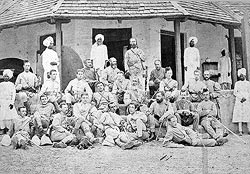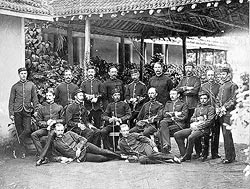The Second Afghan War 1878-79
The 70th Regiment disembarked at Bombay in October 1871 and was based at Nowshera and Peshawar in the Northern Punjab for the next five years. In 1876 it was engaged in operations against the Afridi tribes. Later that year it marched some 450 miles to Multan, and two years later to Quetta from where it became engaged in the Second Afghan War.
For two years before war broke out relations between Afghanistan and India had been strained nearly to breaking point for a number of reasons. The Amir at Kabul had never exercised control over the border tribes for whom preying upon the plains was an essential part of their economy and their tradition. It was an Afghan obsession that to permit a permanent British representative at Kabul would eventually mean British annexation, and this was consistently resisted. However it was also a principle of British foreign policy that the Russians must be kept out of Afghanistan and consequently the admission of a Russian mission to Kabul in 1878 was regarded as a highly provocative act, especially as at that time relationships between the two Powers in Europe had deteriorated to such an extent that war appeared possible.
A British mission with a strong escort was despatched from Peshawar in September 1878. When the advance party reached Fort Ali Masjid on the Afghan frontier, passage to Kabul was formally refused. An ultimatum was then sent to the Amir and no reply having been received by the prescribed day, 20th November, war was declared. Hostilities had been expected for some time and three strong columns immediately crossed the frontier at widely separated points to begin a rapid advance on Kabul and Kandahar, the two principal cities of east Afghanistan.
The 70th (Surrey) Regiment at Subathoo in the Himalayas. Lt
Lumsden, Lt Waldron, Lt Smith, Maj Miller, Q M Jones, Mess Sgt Richards, Maj Collins, |
Officers 1st Bn The Queen’s Royal Regiment, Poona 1877 Lt E O F Hamilton, Lt W S Burrell, Lt C E J Chichester, Surgn Maj J E Clark, Lt Col F J Hercy, Surgn Findley, |
The 70th formed part of the column directed on Kandahar through the Khojak and Gwajha Passes, country which had become familiar to 2nd Queen’s during their exploits thirty years earlier. The Khojak Pass was a formidable obstacle, pack camels died in large numbers crossing it, the guns had to be manhandled in places where the track was unfit for them, and signallers from the 70th stationed on the high peaks of the range suffered severely from the December cold. Kandahar, a large and densely populated town, was not prepared for defence. It was occupied by the British 2nd Division on 8th January. The 70th had been the first British regiment into the field at the start of the campaign and was given the lead into the city. They were the first British regiment to enter Kandahar since its evacuation in 1841. Khaki field dress was adopted by the British regiments during this campaign.
After the fall of Kandahar operations were developed west towards Herat while the other two columns advanced on Kabul which fell in February. A British Resident was then installed and the British forces withdrew from Afghanistan. During the return to India there were numerous sharp skirmishes with unruly tribesmen.
The 70th arrived back at Dera Gazi Khan, one of the frontier stations of the Punjab, on 23rd April. The heat during the six previous marches had been great and two band boys who had gone through the whole campaign in good health died of exhaustion. Then followed two exceedingly hot railway journeys to Multan and Ambala. From there the regiment set out to march to the hill stations at Subathu and Dagshai. On the second day a fatal case of cholera occurred, on the fourth a second and on the following day four more. The regiment then camped for three weeks during which there were several more cases, none of them fatal. It resumed its journey when it appeared there was no likelihood of further infection. Since the beginning of the campaign the 70th had marched about 1,200 miles with few sick and no serious cases of illness until that outbreak of cholera. The regiment remained at Ambala and the neighbouring hill stations until 1880 when it moved to Dinapore. In 1884, by then the 2nd Surreys, it moved to Bareilly and shortly afterwards by rail across India to Bombay where it embarked for Egypt.
Related


